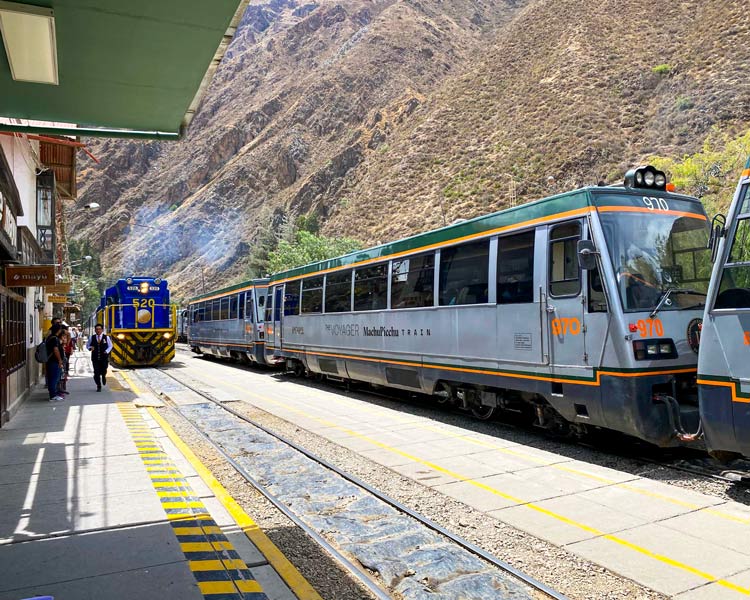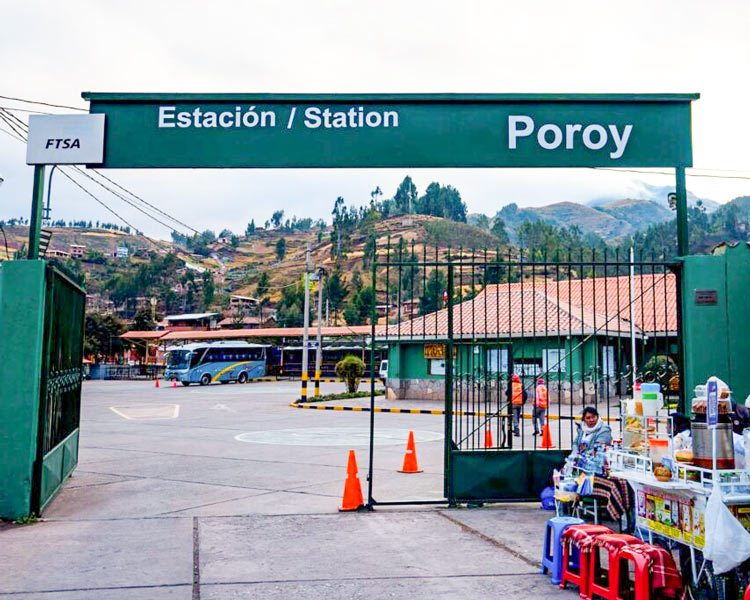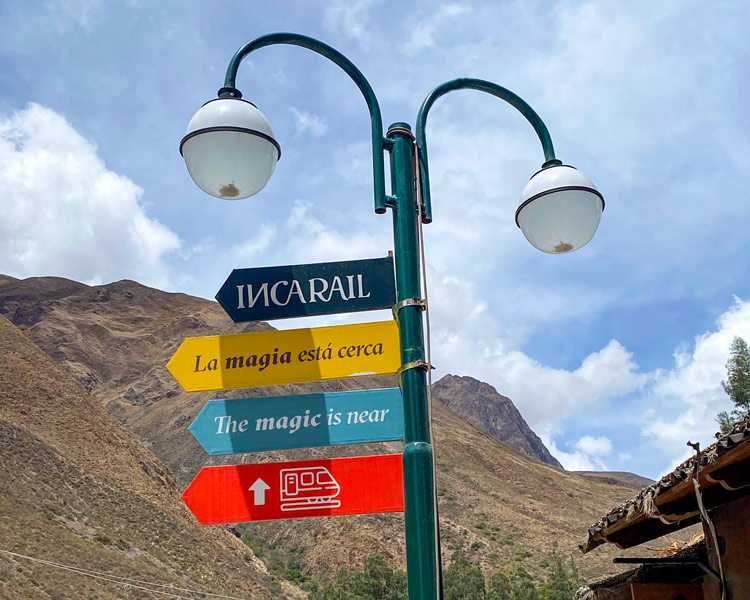Choosing between departing from Poroy or Ollantaytambo may seem like a simple decision, but it can completely change your experience on the way to Machu Picchu. Which is more convenient for your itinerary or type of trip? In this blog, we’ll explain the key differences, the details that few mention, and what you really should consider before booking your train.
Content
General information about both stations

Where is the Poroy train station?
The Poroy train station is located in the Poroy district, approximately 13 kilometers from Cusco’s historic center. The journey by car from Cusco’s Plaza de Armas takes approximately 25 to 30 minutes, depending on traffic. It is an ideal option for those wishing to depart from a nearby area without traveling to the Sacred Valley.
The station is located in a quiet, residential area. Although there are no major shops nearby, it is easily accessible by taxi or private transport. It serves as a departure point for tourist trains to Aguas Calientes, primarily during the dry season, as it usually closes during the rainy season (January to April).
Where is the Ollantaytambo station located?
The Ollantaytambo train station is located in the district of the same name, in the Urubamba province, within the Sacred Valley. It is approximately 72 kilometers from Cusco and takes about two hours to get there by car, either on your own or via tourist transport.
This station is very close to the center of Ollantaytambo, just a short walk from the market, restaurants, and the archaeological site. It’s one of the busiest stations, as it operates year-round and is the most popular stop for tourists who combine their visit to the Sacred Valley with a train ride to Machu Picchu.
Note:
Be punctual, even more than necessary—the stations don’t wait! Arrive at least 30 to 40 minutes early to avoid setbacks, especially if you’re leaving from Ollantaytambo, where the tourist flow is greater and boarding is usually stricter.
What services does each station offer?
Poroy Station offers basic services such as a waiting room, restrooms, and ticket office. Although it is smaller than Ollantaytambo Station, it is comfortable and tends to be less congested. It has staff to provide passenger guidance, but its capacity is limited compared to other larger stations.
The Ollantaytambo station, on the other hand, has better facilities due to the volume of passengers it handles daily. It offers services such as ticket sales, a waiting room, security checkpoints, a boarding area, and restrooms. There are also informal shops and tourist services nearby, making it more dynamic for those waiting for their train or arriving early.
Which companies operate from Poroy and Ollantaytambo?
Both the Poroy and Ollantaytambo stations are operated by two major rail companies: PeruRail and Inca Rail. Both offer tourist services to Machu Picchu with different types of trains, from budget options to luxury trains like the Hiram Bingham.
PeruRail normally operates luxury and tourist services in Poroy, but only during the dry season. Both companies operate year-round in Ollantaytambo, with more frequent departures and more schedule options, making it the most frequently used station for travelers.
Differences in travel time and duration

How long does the train journey from Poroy to Machu Picchu take?
The train ride from Poroy Station to Machu Picchu (Aguas Calientes) takes between 3 hours and 30 minutes to 4 hours, depending on the type of service and the train company. This route is direct and requires no stops or transfers, making it convenient for those departing from Cusco and wishing to avoid additional transfers.
However, it’s important to note that Poroy Station only operates from May to December, as trains do not depart from there during the rainy season (January to April) for safety reasons. During those months, departures are relocated to Ollantaytambo Station, which lengthens the overall travel time.
How long does the train from Ollantaytambo to Machu Picchu take?
The train journey from Ollantaytambo to Machu Picchu takes approximately 1 hour and 45 minutes to 2 hours, depending on the type of train and service chosen. It’s one of the most popular routes, as it operates year-round and offers several daily schedules.
This option is ideal for those touring the Sacred Valley and wishing to continue their journey directly to Machu Picchu. It’s also shorter than the route from Poroy, which saves time if you depart early from Cusco for Ollantaytambo by land transportation.
What is the fastest way to get to Aguas Calientes?
The fastest option in terms of net train time is to depart from Ollantaytambo, as the trip takes less than 2 hours. Considering the total travel time from Cusco, you can reach Aguas Calientes in approximately 4 hours (2 hours by road and 2 hours by train).
Although the train from Poroy is direct, the journey takes longer and is only available part of the year. Therefore, the combination of Cusco and Ollantaytambo by car and then train to Machu Picchu is considered the fastest, most flexible, and safest way to reach Aguas Calientes.
Accessibility and how to get there

How to get to Poroy station from Cusco?
To get to Poroy Station from Cusco, you can take a taxi or hire a private shuttle. The trip takes 25 to 30 minutes from Cusco’s historic center and is a completely paved road. Many tourists prefer to book a taxi in advance to avoid delays.
Another option is to book the shuttle service that some train agencies offer as part of their package. Poroy station is in a quiet area, so there isn’t much direct public transportation. Therefore, it’s best to leave early and check the exact boarding time.
How to get to Ollantaytambo from Cusco?
To get to Ollantaytambo Station from Cusco, you can take a tourist bus, taxi, or colectivo. The journey takes approximately 1 hour and 45 minutes to 2 hours, and the route crosses the Sacred Valley. The colectivos depart from Pavitos Street in Cusco and are an economical option, although less comfortable if you have a lot of luggage.
Another alternative is to hire private transportation or a tour service that will pick you up at your hotel. This option is more convenient and will drop you off directly at the station. Many agencies that sell train tickets also include this ground transfer, which makes travel logistics easier.
Which option is more comfortable or direct for tourists?
In terms of convenience, Poroy Station is the most direct option, as it avoids the long road trip and allows you to depart directly from the outskirts of Cusco. It’s ideal for those looking to avoid additional connections and travel more leisurely, during the dry season.
On the other hand, Ollantaytambo offers more schedules, more frequent trains, and year-round operation, making it more flexible for most travelers. Although it requires a road trip, many people take the opportunity to visit the Sacred Valley before boarding the train, making the experience more complete.
Advantages and disadvantages of each season

Advantages of taking the train from Poroy
One of the main advantages of taking the train from Poroy Station is that it’s much closer to Cusco, which reduces the time and effort of ground transportation. This is ideal for those staying in the city and want to avoid long trips before boarding the train to Machu Picchu.
Additionally, trains departing from Poroy tend to be more comfortable or tourist classes, such as the Vistadome or the Hiram Bingham. This means that the services offered are generally of higher quality, and since it’s a less crowded station than Ollantaytambo, the boarding experience is smoother.
Note:
Buy your tickets in advance; don’t leave them until the last minute. Trains fill up quickly, especially during peak season. Booking days (or weeks) in advance ensures better schedules and avoid paying more for limited availability.
Advantages of leaving from Ollantaytambo
The main advantage of departing from Ollantaytambo is that the station operates year-round, even during the rainy season, unlike Poroy, which closes between January and April. This offers greater flexibility for planning your trip without worrying about weather conditions.
Another great advantage is the wide range of schedules and trains, as Ollantaytambo is the most frequently used departure point for train companies. Furthermore, many travelers take the opportunity to visit the Ollantaytambo archaeological site before continuing on to Machu Picchu, combining the trip with an additional cultural visit.
Common disadvantages in each season
In the case of Poroy, one disadvantage is that it doesn’t operate year-round, which limits its use to the dry season. Furthermore, since it’s a small station and somewhat far from commercial areas or restaurants, there isn’t much to do if you arrive too early.
Regarding Ollantaytambo, a common disadvantage is that it requires a longer land trip from Cusco, which can be exhausting for some tourists, especially if they leave very early. It’s also a very busy station, which can cause lines, crowds, or delays during certain peak hours.
Frequently Asked Questions
-
Which season is best if I stay in Cusco?
Poroy Station is the closest to downtown Cusco (about a 30-minute taxi ride), so it’s more convenient if you’re staying in the city.
-
Why do many agencies prefer Ollantaytambo?
Because it has more frequent trains, fewer weather-related cancellations, and operates year-round. It also allows for combined tours to the Sacred Valley.
-
Can I change my ticket from Poroy to Ollantaytambo?
Yes, but it depends on train availability and the company’s policy (Inca Rail or Peru Rail). It’s recommended to book in advance.
-
Do Poroy or Ollantaytambo have better scenery during the trip?
Both routes are scenic, but from Ollantaytambo the journey is longer and passes through greener, more tropical areas, which travelers tend to enjoy more.
-
Which is better if I’m traveling with children or older adults?
Poroy is better because of its proximity to Cusco, which avoids long transfers. But if you’re traveling during the rainy season, Ollantaytambo is safer due to its easy access.
-
Is there public transportation from Cusco to Ollantaytambo?
Yes, you can take collective buses or minibuses from Pavitos Street. The journey takes between 1 hour and 45 minutes to 2 hours, depending on traffic.
-
Which is safer and less congested?
Ollantaytambo has better infrastructure, greater capacity, and more daily trains. Poroy tends to be congested during peak season because it’s smaller.
-
Which station has the fewest cancellations or delays?
Ollantaytambo. Poroy suspends operations during the rainy season (January to March) for safety reasons, while Ollantaytambo operates year-round.
-
Which one is more recommended for first-time visitors?
Ollantaytambo is more convenient for first-time visitors to Machu Picchu. It has more available time slots and fewer cancellation risks.
-
Can luggage be left at both stations?
Yes, both stations have storage facilities, although it’s best to confirm with the train company before your trip, as they aren’t always available.
